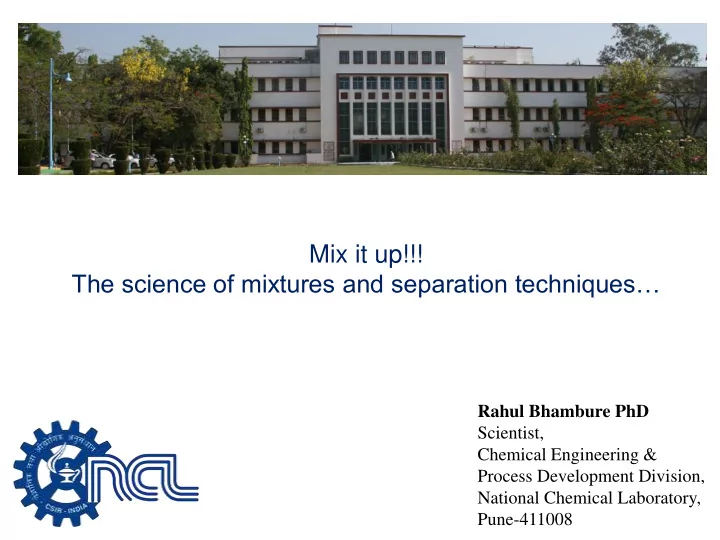

Mix it up!!! The science of mixtures and separation techniques… Rahul Bhambure PhD Scientist, Chemical Engineering & Process Development Division, National Chemical Laboratory, Pune-411008
What are mixtures? Mixtures are the physical combinations of two or more substances in which their identities are retained in such a way that no chemical reaction occurs. Solid Liquid Gas How mixtures are formed? 1
Mixtures… Liquid-Solid Gas-Solid Liquid-Gas Gas-Liquid Liquid-Liquid Solid-Liquid Gas-Gas Solid-Gas Solid-Solid 2
Why to separate mixtures? Petrochemical industry Chemical Speciality and Pharmaceutical fine chemical industry Engineering industry Biotechnology industry Separating various mixtures is a very complex task in various chemical industries. 3
Economics of the chemical engineering processes Upstream processing (Making a product) Downstream processing (Separating a product from impurities) Final purified product Almost 60-70 % manufacturing cost for various chemicals is due to downstream processing operations which involves various separation techniques like centrifugation, membrane separations, liquid-liquid separations, chromatography 4 etc.
Case study: medicine production Manufacturing platform for rHu insulin involves combination of various separation techniques. 5
Do you know how rHu Insulin is made? Where is the mixture but? 6
Solid-liquid mixture and separation techniques Any guess? Membrane separations Centrifugation and A “magic technique”…. How to separate bacterial cells from rHu insulin in liquid media ? 7
Membrane separations Membrane separation is a technology which selectively separates materials via pores in the molecular arrangement of a continuous structure Various types of membrane filtration techniques: • Microfiltration • Ultrafiltration • Nanofiltration 8
What we need to know before designing a membrane separation process? Scientist Engineer • Synthesis of new membranes • • Transport phenomenon inside the Scale-up of the separation process membrane • Understand the impact of various processing parameters on separation efficiency of the membranes 9
Demo I: Membrane separations 10
Centrifugation Centrifugation is a process which involves the application of the centrifugal force for the sedimentation of heterogeneous mixtures with a centrifuge. “A Fat Man” “A little boy” experiment…. How we use centrifuge for separating bacteria from rHu Insulin? 11
“Magic technique” for separating bacteria from rHu Insulin …. I don’t have money to buy membranes or centrifuge? 12
Flocculation Flocculation refers to the process by which fine particulates are caused to clump together into a floc. The floc may then float to the top of the liquid (creaming), settle to the bottom of the liquid (sedimentation). Flocculation process involves addition of various flocculants like aluminum sulfate, iron sulfate to the solid liquid mixtures which helps in formation of clumps of the fine particles. 13
Liquid-liquid extraction Liquid – liquid extraction (LLE), also known as solvent extraction and partitioning, is a method to separate compounds based on their relative solubilities in two different immiscible liquids, usually water and an organic solvent. It is an extraction of a substance from one liquid into another liquid phase. Is it possible to use liquid-liquid extraction for separating bacteria from rHu Insulin? 14
Aqueous two-phase extraction (ATPE) Aqueous two-phase extraction (ATPE), is a unique liquid-liquid extraction, involves a transfer of solute from one aqueous phase to another. Aqueous two-phase systems (ATPS) are clean and green alternatives for traditional organic-water solvent extraction systems. Aqueous two phase extraction system is effectively used for extraction of various antibiotics and therapeutic enzymes. 15
Chromatography Chromatography is a physical method of separation that distributes components to separate between two phases, one stationary (stationary phase), the other (the mobile phase) moving in a definite direction. The eluate is the mobile phase leaving the column. 16
Chromatography Different modes of chromatography like ion exchange chromatography, size exclusion chromatography, hydrophobic interaction chromatography separate various types of the impurities from the product based on different types of physical or chemical interactions Chromatography is a most widely used separation technique for manufacturing of various medicinal molecules 17
Size Exclusion Chromatography Size - exclusion chromatography (SEC), also known as molecular sieve chromatography, is a chromatographic method in which molecules in solution are separated by their size, and in some cases molecular weight. It is usually applied to large molecules or macromolecular complexes such as proteins and industrial polymers. 18
Conclusions • With a few exceptions, elements or compounds are naturally found in an impure state. Often these impure raw materials must be separated into their purified components before they can be put to productive use, making separation techniques essential for the modern industrial economy. • In chemical industry the purpose of a separation technique is mainly focused on separating the pure product from various impurities formed during the synthesis of the selected product. • The separation can be done on a small scale, effectively a laboratory scale or on a large scale, effectively an industrial scale for preparative purposes, or on some intermediate scale. • Distillation is a backbone separation technique in petrochemical industry which helps refining of a crude oil, where as chromatography act as workhorse purification step for manufacturing of various pharmaceutical molecules. 19
Acknowledgements • Dr. Manoj Kamble • Mr. Ranjit Chaudhari 20
Questions? Questions Comments 21
Recommend
More recommend